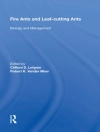When we talk about forests, we talk about 30% of our planet’s land surface 6 area. In 2000 there was an estimated 3 870×10 ha of forest worldwide, of which 1 5% is in forest plantations and 95% in natural forests (FAO 2003). Forests are not only a source for timber; they also generate significant nonwood goods and services, mitigate climate change, conserve biological diversity, provide prot- tion from natural hazards, and not least: provide recreational areas for an increasingly urbanized world population. The availability of timber and n- wood goods and services is waning as deforestation and degradation of tro- cal forests continue. While forest area has stabilized or is slightly increasing in the boreal and temperate regions, the annual loss of forest area in the tropics and subtropics is decreasing. Between 1990 and 2000 the annual rate of defor- 6 estation was estimated to be 14. 6×10 ha (approximately 0. 38%) and took place mainly in tropical and subtropical forests (FAO 2003). The net annual rate of 6 change is about 9. 4×10 ha (0. 2%). Maintaining and enhancing forest areas and the vitality of forest ecosystems is a widely accepted political goal, which is often opposed by conflicting demands of various stakeholders.
Cuprins
Forest Inventories – an Overview.- Forest Mensuration.- Sampling in Forest Surveys.- Remote Sensing.- Geographic and Forest Information Systems.- Multiresource Forest Inventory.
Despre autor
Michael Köhl is Professor of World Forestry at the University of Hamburg, Germany, and head of the Institute for World Forestry, at the Federal Research Centre for Forestry and Forest Products. His main research interests are in the field of quantitative methods for natural resources assessments and forest planning, including statistical design and analysis of complex sample surveys, remote sensing, information systems and GIS. He has authored more than 150 scientific papers. He was former leader of IUFRO’s S4.02 ‘Forest Resources Inventory and Monitoring’, leader of the Team of Specialists for the UN-FAO/ECE Temperate and Boreal Forest Resources Assessment (TBFRA) 2000, coordinator for the Ministerial Conference on the Protection of Forests in Europe (MNPFE) – an advisory group on the Improvement of the Pan-European Indicators for Sustainable Forest Management – and lead author of the UN-IPCC ‘Good Practice Guidance for Land-Use, Land-Use Change and Forestry. He is currently an Associate Editor of the Schweizerische Forstzeitung (Swiss Journal of Forestry) and Subject Editor of the European Journal of Forest Research. He is Honorary Member of the Finnish Society of Forest Science, member of the Scientific Advisory Board of the European Forest Institute, and Associate Member of the Italian Academy of Forest Sciences .
Marco Marchetti is Full Professor of Forest Inventory and of Forest Conservation at the University of Molise (Italy). He has a research record of 20 years in the domain of GIS and remote sensing for forest management and forest assessment. He is the principal investigator in several national and international projects. Research activities span the domain of development and application of new technologies. Current research focus is on multi-resources inventory and forest mapping, forest management and land planning, fire monitoring and biodiversity assessment. Accomplishments have beencommunicated in more than100 publications. Marco acts in the editorial boards of national and international journals. He was former deputy of IUFRO’s S8.07.01 ‘Key factors and ecological functions for forest biodiversity’. Currently he is leader of IUFRO’s S4.02 ‘Forest Resources Inventory and Monitoring’, and member of the Team of Specialists for the UN-FAO/ECE Forest Resources Assessment. Marco is ordinary member of the Italian Academy of Forest Sciences and scientific advisor of the Italian Remote Sensing Association.
Steen Magnussen is a senior Research Scientist with the Canadian Forest Service (Natural Resources Canada). His research covers statistics and biometrics of multi-resource forest inventories, spatial analysis, classification and accuracy of forest inventory information. Steen is a member of the American Statistical Association and the International Association of Statistical Computing. He is currently an Associate Editor of the European Journal of Forest Research. Similar positions were held with Forest Science, the Canadian Journal of Forest Research, and the Forestry Chronicle. Steen holds a Ph.D. from the University of Göttingen (Germany) and a Master of Science in Forestry from the Agricultural University of Copenhagen (Denmark) His research has been published in more than 100 peer reviewed scientific journals and over 40 articles and technical reports.












